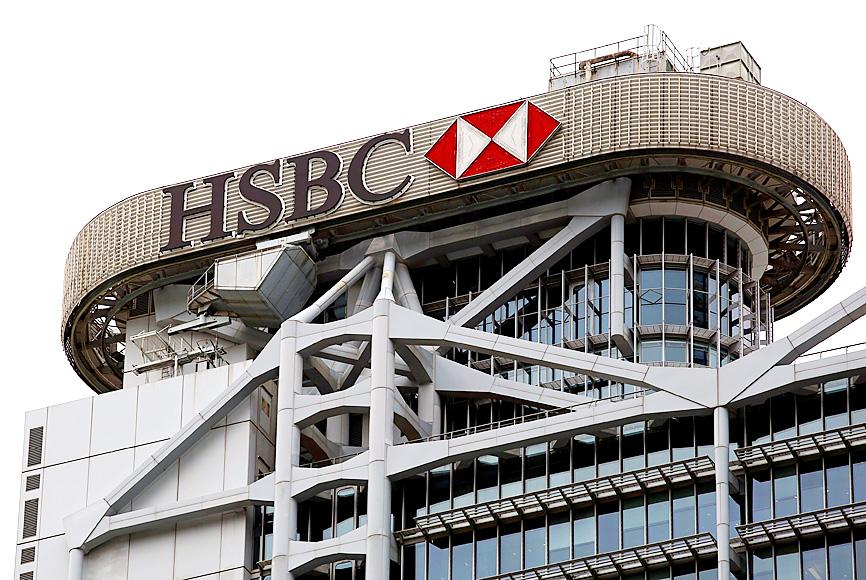HSBC Holdings PLC yesterday posted its best quarter since the COVID-19 pandemic began as an improving economic outlook drove optimism about the ability of borrowers to repay loans and its strategic reset to Asia remained on track.
First-quarter profit more than doubled as US$400 million of loan loss reserves were released, spurred by the rollout of vaccination programs in markets such as the UK.
Europe’s largest bank said that its increasing focus on servicing wealthy Asians had also got off to a strong start.

Photo: Reuters
Adjusted pretax profit of US$6.4 billion for the three months to the end of last month comfortably beat analysts’ forecasts.
The firm’s investment bank joined rivals in benefiting from active markets, as a 55 percent surge in equity trading helped lift the division’s revenue.
“The economic outlook has improved, although uncertainties remain,” HSBC chief executive officer Noel Quinn said in a statement. “We carry good momentum into the second quarter.”
Easing credit losses helped it turn around its UK business and it also posted a profit in the US even as it embarks on shifting billions of dollars to Asia.
Weighed down by low interest rates, HSBC is seeking out more fee-based income, targeting to become a leader in wealth management in an increasingly affluent Asia.
Asia continued to be its biggest profit center, but earnings there were relatively unchanged from a year earlier. It saw big jumps in profit at all of its major divisions.
With the virus restrictions easing in major markets, HSBC was boosted by the reversal in credit losses. This year, such losses are now seen below the medium-term range of 30 to 40 basis points of average loans it indicated at its latest annual results, the lender said.
However, Quinn said that the bank was watching closely developments in India, which has seen an upsurge in infections.
“We have to see how the pandemic develops in India, and we are watching very closely,” he said.
The bank said that it is continuing negotiations on a potential sale of its retail operations in France.
In the US, it is exploring “both organic and inorganic options for our retail banking franchise,” it said.
While attention has focused on the businesses it is attempting to sell, HSBC chief financial officer Ewen Stevenson said that the bank was looking at possible acquisitions, mainly focused on its Asian wealth business, which is at the heart of its strategic repositioning.
Asked about Citigroup Inc’s sales of parts of its Asian business, Stevenson said “very few of them” would be a good fit for HSBC.
“We are looking at other options in the region, predominantly in the wealth space,” Stevenson said in a Bloomberg Television interview.
HSBC has also spent the past year adapting its working practices as a result of the pandemic.
Quinn this month said that he would turn the entire executive floor of the bank’s London headquarters into meeting rooms and it eventually aims to cut its office space by about 40 percent.
It aims to cut its global office footprint by about 20 percent this year, HSBC said.

CHIP RACE: Three years of overbroad export controls drove foreign competitors to pursue their own AI chips, and ‘cost US taxpayers billions of dollars,’ Nvidia said China has figured out the US strategy for allowing it to buy Nvidia Corp’s H200s and is rejecting the artificial intelligence (AI) chip in favor of domestically developed semiconductors, White House AI adviser David Sacks said, citing news reports. US President Donald Trump on Monday said that he would allow shipments of Nvidia’s H200 chips to China, part of an administration effort backed by Sacks to challenge Chinese tech champions such as Huawei Technologies Co (華為) by bringing US competition to their home market. On Friday, Sacks signaled that he was uncertain about whether that approach would work. “They’re rejecting our chips,” Sacks

Taiwan’s exports soared 56 percent year-on-year to an all-time high of US$64.05 billion last month, propelled by surging global demand for artificial intelligence (AI), high-performance computing and cloud service infrastructure, the Ministry of Finance said yesterday. Department of Statistics Director-General Beatrice Tsai (蔡美娜) called the figure an unexpected upside surprise, citing a wave of technology orders from overseas customers alongside the usual year-end shopping season for technology products. Growth is likely to remain strong this month, she said, projecting a 40 percent to 45 percent expansion on an annual basis. The outperformance could prompt the Directorate-General of Budget, Accounting and

NATIONAL SECURITY: Intel’s testing of ACM tools despite US government control ‘highlights egregious gaps in US technology protection policies,’ a former official said Chipmaker Intel Corp has tested chipmaking tools this year from a toolmaker with deep roots in China and two overseas units that were targeted by US sanctions, according to two sources with direct knowledge of the matter. Intel, which fended off calls for its CEO’s resignation from US President Donald Trump in August over his alleged ties to China, got the tools from ACM Research Inc, a Fremont, California-based producer of chipmaking equipment. Two of ACM’s units, based in Shanghai and South Korea, were among a number of firms barred last year from receiving US technology over claims they have

BARRIERS: Gudeng’s chairman said it was unlikely that the US could replicate Taiwan’s science parks in Arizona, given its strict immigration policies and cultural differences Gudeng Precision Industrial Co (家登), which supplies wafer pods to the world’s major semiconductor firms, yesterday said it is in no rush to set up production in the US due to high costs. The company supplies its customers through a warehouse in Arizona jointly operated by TSS Holdings Ltd (德鑫控股), a joint holding of Gudeng and 17 Taiwanese firms in the semiconductor supply chain, including specialty plastic compounds producer Nytex Composites Co (耐特) and automated material handling system supplier Symtek Automation Asia Co (迅得). While the company has long been exploring the feasibility of setting up production in the US to address